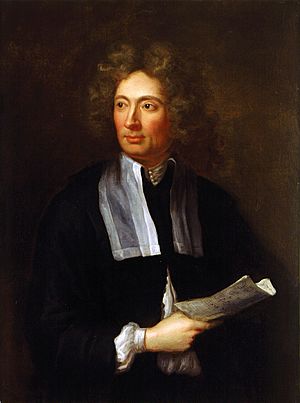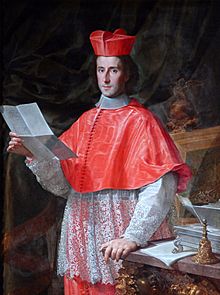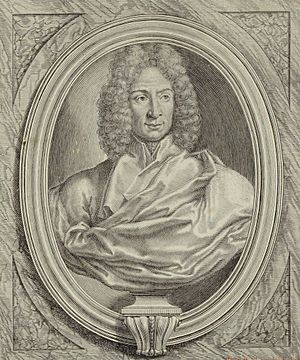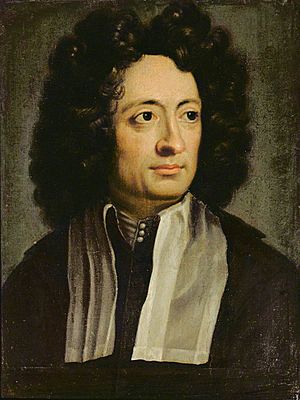Arcangelo Corelli facts for kids
Arcangelo Corelli (born February 17, 1653 – died January 8, 1713) was a famous Italian composer and violin player from the Baroque period. This was a time in music history roughly from 1600 to 1750. Corelli's music was very important. It helped create modern music styles like the sonata (a piece for one or two instruments) and the concerto (a piece for a solo instrument with an orchestra). He also helped make the violin a leading instrument. His work was key in developing modern tonality, which is how music uses different notes and chords to create a sense of key.
Corelli trained in Bologna and Rome. He spent most of his life there, supported by rich people who loved music. Even though he only published six collections of music, he became very famous across Europe. Five of his collections were Trio Sonatas (for three instruments) or solo sonatas. One collection was of Concerti grossi (a type of concerto). His music became a model for many other composers.
People admired his music for its balance and beauty. It had rich sounds and clear, expressive melodies. Corelli was one of the first to fully use the new tonal system in his music. This system had been developing for about 200 years. As a violin player, he was considered one of the best of his time. He helped create modern violin playing techniques. Many of his students spread his style across Europe. This helped make the violin one of the most important solo instruments. He also played a big part in how the traditional orchestra grew.
Corelli was a major figure in Roman music and was respected worldwide. Many royal courts wanted him to play for them. He was part of the most important artistic group of his time, the Pontifical Academy of Arcadia. People called him "the new Orpheus" and "the prince of musicians." His fame continued even after he died. Today, his sonatas are still used to teach music students. They are also played in concerts. His place in the history of Western music is very important. He is seen as one of the greatest masters from the late 17th century and early 18th century.
Contents
Life of Arcangelo Corelli
Early Life and Education
Arcangelo Corelli was born on February 17, 1653, in a small town called Fusignano. This town was in the Papal States (parts of Italy ruled by the Pope). His family had owned land in Fusignano since 1506. Corelli's father died five weeks before he was born. So, his mother, Santa, raised him and his four older brothers and sisters.
There are many stories about Corelli's life, but not many official records, especially about his childhood. We don't know much about his early music lessons.
Learning Music
A poet named Giovanni Mario Crescimbeni, who knew Corelli, said that Corelli first studied music with a priest in Faenza. Then he went to Lugo. In 1666, he moved to Bologna. Bologna was a big music center at the time. It had many great violin teachers. Some stories say Corelli studied with famous violinists like Giovanni Benvenuti and Giovanni Battista Bassani. It's also said that a singer named Matteo Simonelli taught him how to write music in the style of Giovanni da Palestrina. Corelli himself once said that his music education was mostly focused on the violin.
Records show that Corelli became a member of the Accademia Filarmonica of Bologna by 1670. He was only seventeen, which was very young. He was known as "Il Bolognese" on his first three published music collections. But it's not clear how long he stayed in Bologna.
Starting His Career
There are stories that Corelli traveled outside Italy to France, Germany, and Spain. But there is no real proof of these trips. For example, one story says he went to Paris at age nineteen. It claims he was chased away by a jealous composer named Jean-Baptiste Lully. This story likely came from Jean-Jacques Rousseau.
We don't know exactly when Corelli arrived in Rome. But he was definitely playing music there by 1675. He was called "Arcangelo Bolognese" then. He played violin in church events and French national celebrations. By 1676, he was playing second violin to a famous musician named Carlo Mannelli. Rome didn't have a permanent orchestra. But Corelli quickly became well-known. He played in many groups supported by rich people, like Cardinal Benedetto Pamphili.
Becoming Famous
In 1687, Corelli led music performances for Queen Christina of Sweden. He was also a favorite of Cardinal Pietro Ottoboni. This cardinal later became Pope Alexander VIII. From 1689 to 1690, Corelli was in Modena. The Duke of Modena was very kind to him. In 1706, Corelli was chosen to be a member of the Arcadian Academy of Rome. This was a very important group of artists and thinkers.
In 1708, he returned to Rome and lived in Cardinal Ottoboni's palace. He also visited Naples at the king's invitation that same year. Corelli's way of playing and teaching the violin was very important. His students, like Francesco Geminiani and Pietro Locatelli, helped spread his style. Many famous violin players of the 1700s looked up to Corelli.
Corelli's music for the violin was groundbreaking for chamber music (music for a small group of instruments). His influence spread beyond Italy. His works were key in the music of many composers. These included Antonio Vivaldi, George Frideric Handel, Johann Sebastian Bach, and François Couperin. Bach even based an organ piece (BWV 579) on Corelli's Opus 3. Handel's Opus 6 Concerti Grossi were inspired by Corelli's own Opus 6 Concerti.
Corelli was very important to the music scene in Rome. He was welcomed by the richest families. For a long time, he led the famous Monday concerts at Cardinal Ottoboni's palace.
His Death
Corelli died in Rome. He had a lot of money and a valuable collection of art and violins. These were the only luxuries he enjoyed. He left everything to his friend and supporter, Cardinal Ottoboni. The Cardinal kindly gave the money to Corelli's family. Corelli is buried in the Pantheon in Rome.
Corelli's Musical Works
Corelli's music came from the height of the Baroque period. This time was known for rich and dramatic art. His music grew from older styles but became more independent. New ideas and the influence of theater led to new ways of making music. This included new harmonies and instrumental techniques. During this time, the tonal system became fully established. This system replaced older ways of organizing music.
Corelli's music often used a style called continuo or figured bass. In this style, the lowest and highest parts of the music are written out. The musician playing the middle parts fills them in, guided by numbers. The main melody was very important, and this helped the "virtuoso soloist" (a very skilled player) become famous.
Even though the Baroque period loved dramatic and unusual things, Corelli's music was different. He preferred balance, order, and clear expression. He aimed for perfection in his musical forms. Many critics, both then and now, praised his classical style. The Larousse Encyclopedia of Music said that Corelli showed a "noble interest in balance and order." He gave the musical forms he used a "nobility and perfection."
Corelli planned his works carefully. He published them only after many changes and revisions. His last collection took over thirty years to finish. He once wrote that he rarely felt confident enough to publish his music. This careful, organized way of working, and his desire for perfection, made him a "classic" composer. This was different from the wild, improvisational style of some other Baroque artists.
Corelli was also strict about the types of music he wrote. He focused on the trio sonata, the solo sonata, and the concerto grosso. All his music was for string instruments, with a continuo accompaniment. This could be played by an organ, harpsichord, lutes, or theorbos. He didn't write any music for voices. But his instrumental pieces show a strong influence from vocal music in their expression.
Corelli's music was very important in establishing the circle of fifths as a key part of chord progressions. This was fundamental for the tonal system. Music experts like Manfred Bukofzer say that Corelli fully developed tonality in instrumental music. Corelli's music doesn't use many unusual notes (chromaticisms). But he often used dissonances (notes that sound clashing) for expression. These were always used carefully and resolved well. Critics also note how well he blended polyphonic (multiple independent melodies) and homophonic (one main melody with chords) elements.
Corelli was influenced by the Bolognese school of music, including Giovanni Benvenuti and Giovanni Battista Bassani. The French composer Jean-Baptiste Lully and the Venetian school also influenced him. Some experts also believe that Giovanni da Palestrina influenced Corelli's polyphonic style.
Corelli's clear and expressive melodies were seen as perfect examples of good taste. Many famous musicians were inspired by Corelli's style. These included George Frideric Handel, Johann Sebastian Bach, Antonio Vivaldi, and Georg Philipp Telemann. In Rome, his influence was so strong that no composer could avoid it. Corelli, along with Torelli and Vivaldi, was a key figure in making the concerto a popular music style that is still loved today.
An 1827 music dictionary said that Corelli's concertos had lasted longer than his other works. It praised their pure harmony and majestic sound. Michael Talbot, a music writer, noted that it's hard to explain why this collection is still so popular, given its simplicity.
Corelli wrote 48 trio sonatas, 12 violin and continuo sonatas, and 12 concerti grossi.
Six sets of twelve compositions are definitely by Corelli. They were published between 1888 and 1891. He also wrote a few other pieces.
- Opus 1: 12 sonate da chiesa (trio sonatas for 2 violins and continuo) (Rome 1681)
- Opus 2: 12 sonate da camera (trio sonatas for 2 violins and continuo) (Rome 1685)
- Opus 3: 12 sonate da chiesa (trio sonatas for 2 violins and continuo) (Rome 1689)
- Opus 4: 12 sonate da camera (trio sonatas for 2 violins and continuo) (Rome 1694)
- Opus 5: 12 Suonati a violino e violone o cimbalo (6 sonate da chiesa and 6 sonate da camera for violin and continuo) (Rome 1700). The last sonata is a set of variations on a tune called La Folia.
- Opus 6: 12 concerti grossi (8 concerti da chiesa and 4 concerti da camera for a small group of soloists (concertino of 2 violins and cello), a larger string group (ripieno), and continuo) (written in the 1680s, published in Amsterdam 1714)
- op. post.: Sinfonia in D minor, WoO 1
- op. post.: Sonata a Quattro, WoO 2 (published in Amsterdam, 1699)
- op. post.: Sonata a Quattro, WoO 3 (published in Amsterdam, 1699 – possibly incomplete or not by Corelli)
- op. post.: Sonata a Quattro for Trumpet, 2 Violins & B.C, WoO 4
- op. post.: 6 Sonate a tre, WoO 5–10 (Amsterdam 1714)
Corelli's Legacy
Corelli's concerti grossi have remained popular in Western culture. For example, part of his Christmas Concerto, Op. 6 No. 8, is in the movie Master and Commander: The Far Side of the World. Also, Corelli's Op. 6 No. 2 inspired Sir Michael Tippett's Fantasia Concertante on a Theme of Corelli. The British composer E. Florence Whitlock also wrote Variations on a Theme by Corelli for violin in 1968.
See Also
 In Spanish: Arcangelo Corelli para niños
In Spanish: Arcangelo Corelli para niños
Images for kids







